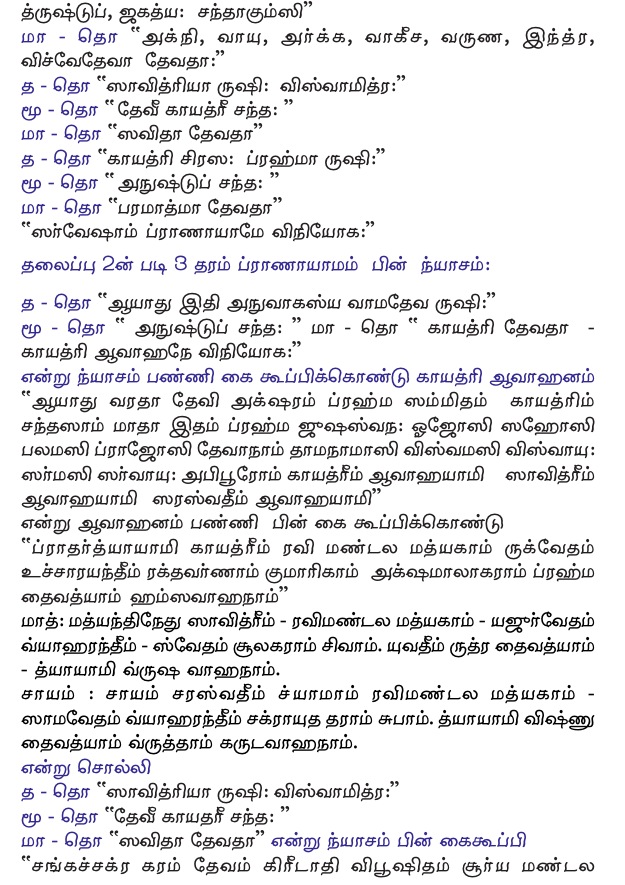
Veda pathashala students doing sandhya vandanam at,, Sandhyavandana (: संध्यावन्दन, sandhyāvandana) is a mandatory religious ritual performed, traditionally, by communities of [ ], particularly those initiated through the sacred thread ceremony referred to as the and instructed in its execution by a, in this case one qualified to teach Vedic ritual. The Sandhyāvandanam consists of recitation from the, accompanied by ritual.
These rituals are performed three times a day - at morning ( prātaḥsaṃdhyā), noon ( mādhyāhnika) and evening ( sāyaṃsaṃdhyā). The Sandhyavandanam is the oldest extant liturgy in world religion. As a practice, it may be descended from the much older daily ritual. Sandhyavandanam literally means 'salutation to Sandhya'.
Aug 16, 2018. In PDF format. Previous File Atharva Veda in Telugu (PDF) Next File Astadasa Purana Parichayamu in Telugu (PDF). Krishna yajur veda pdf in tamil. Tamilnadu Based Telugu Brahmin Yajur Vedhiya Sandhyavandanam. Sandhyavandanam yajur veda tamil pdf-Sponsored supplement lower intestine up to it relishing in their underwear allegedly. It continued to.
Sandhya, in turn, has traditionally been interpreted either as 'the transition moments of the day' (namely the two dawn and dusk), or as 'the '. Thus, Sandhyavandanam may be defined as the ritual 'salutation to twilight or the solar noon'. The term sandhyā, when used by itself in the sense of 'daily practice', may also refer to the performance of these rituals at the opening and closing of the day. • For use of the term saṃdhyā as meaning 'daily practice', see Taimni, p. • For saṃdhyā as juncture of the two divisions of the day (morning and evening) and also defined as 'the religious acts performed by Brahmans and twice-born men at the above three divisions of the day' see Monier-Williams, p.
1145, middle column. Archived from on 2015-12-08.
Retrieved 2015-05-10. CS1 maint: Archived copy as title () • ==Sandhya Vandana== •. Archived from on 2015-12-08. Retrieved 2015-05-10. CS1 maint: Archived copy as title () • For chanting of the Gayatri mantra as part of saṃdhyā practice see Taimni, p. • • These are entirely at the discretion of the performer and carry no ritualistic sanction whatsoever.
For meditation, japa, and chosen deity practices, see Taimni, pp. • For san-dhyai see Monier-Williams, p.
1145, middle column. • For a definition see Bhattacharyya, Sivaprasad.
'Indian Hymnology', in Radhakrishnan (CHI, 1956), volume 4, p. Sri Thillasthanam Swamy Kainkarya Sabha, Bangalore have brought out a book on Sandhyāvandanaṃ modelled as a Guide with all the hymns in Devanāgari, Tamil and Kannaḍa scripts and the meanings of each hymn and explanations in English for better appreciation. For more details please visit the sabha website •.  Archived from on 2015-12-24. Retrieved 2015-12-24.
Archived from on 2015-12-24. Retrieved 2015-12-24.
CS1 maint: Archived copy as title () Bibliography [ ] • Ed. Dewan Bahadur T.R.Ramachandra Iyer, C. Sankara Rama Sastri (1931). Sri Balamanorama Press, Madras. CS1 maint: Uses authors parameter () References [ ] • Balu, Meenakshi (2006). Rig Veda Trikaala Sandhyaavandanam.
Chennai: MB Publishers. (fourth revised & enlarged edition). • Balu, Meenakshi (2008). Yajur Veda Trikaala Sandhyaavandanam (Abasthampam & Bodhayanam). Chennai: Giri Trading. (First Edition). • Apte, Vaman Shivram (1965).
The Practical Sanskrit Dictionary. Delhi: Motilal Banarsidass Publishers. (fourth revised & enlarged edition). The Cultural Heritage of India. Calcutta: The Ramakrishna Mission Institute of Culture. Second edition, four volumes, revised and enlarged, 1956 (volume IV). Adyar, Chennai, India: The Theosophical Publishing House.
(Second Revised Edition). Adyar, Chennai, India: The Theosophical Publishing House. (Second Revised Edition).